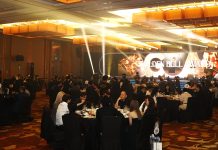Troubled water treatment company Hyflux will finally go into liquidation now that a court has approved an application for winding up the company, marking the end to a charismatic founder’s once high-flying startup.
“I am grateful for all the assistance rendered by all parties,” Justice Aedit Abdullah said on Wednesday during the Singapore court hearing, conducted through videoconferencing, as he granted approval to begin Hyflux’s winding up – more than three years after the company filed for bankruptcy protection.
The hearing was originally set for July 12 but was adjourned as Utico, a utilities company from the United Arab Emirates, attempted to intervene in the company’s liquidation. Utico had earlier proposed a restructuring plan, but Hyflux’s judicial managers had said that Utico’s offer did not meet the minimum acceptable conditions for them.
Utico’s offer was thrown out on Wednesday, with the court asking the company to pay up 5,000 Singapore dollars ($3,650) for the work done to consider its appeal, as the judge moved to approve Hyflux’s liquidation.
Led by a prominent entrepreneur, Hyflux was able to raise plenty of funds by providing solutions to societal problems. In this regard, it was little different from Southeast Asia’s current crop of fast-growing startups.
But as Southeast Asia’s blockbuster young companies head toward initial public offerings, is there anything they can learn from the Hyflux affair?
The company was founded in 1989 by Malaysia-born entrepreneur Olivia Lum, who until then was a chemist at British multinational Glaxo (currently GlaxoSmithKline). Her job handling water disposal at the pharmaceutical company gave her the idea to go off on her own and launch a water treatment business.
Wielding its own water-recycling technology, Hyflux grew steadily in its early days. It quickly became a star in the resource-poor, city-size country, where water security sits near the top of the national agenda.
Riding the buzz it created in Singapore it expanded into China and the Middle East.
It listed on the Singapore Exchange in January 2001, which Lum would later tell, was a huge breakthrough that gave Hyflux more access to funds.
Hyflux’s market value would go on to peak at SG$2 billion ($1.5 billion) in December 2010.
Also in 2010, the company’s net profit peaked, at SG$88 million on revenue of SG$569 million.
The company was praised as a rare success story in the blip of a country long dominated by state-linked companies and traditional conglomerates, and Lum was put on a pedestal for her charismatic entrepreneurialism.
Lum’s background helped build this perception. Orphaned as an infant, she grew up in a small town, lived in a shabby house that lacked electricity and running water, she told in a 2016 interview.
But the teenager was gifted, and at 15 she moved to Singapore all by herself to attend school. She would pay her way through college with money earned waitressing and tutoring.
When Lum won the EY World Entrepreneur Of The Year award in 2011, the Ernst & Young consultancy described her as “a role model for entrepreneurs and for women across Asia and the world.”
Racking up funds, profits, revenue and accolades, Hyflux in 2016 entered the electricity business, expecting profits that would subsidize the cost of producing water.
But as Singapore liberalized its electricity market, electricity prices collapsed. With its new business model suddenly in shambles, Hyflux in 2017 fell into a net loss of SG$116 million. In May 2018, the company filed for court protection with debt of SG$2.8 billion.
“While Olivia was a brilliant entrepreneur, she lacked management skills to run a growing business,” said Mak Yuen Teen, a corporate governance expert and associate professor at the National University of Singapore Business School. “And she failed to bring in the right people to address her own weaknesses.”
Mak pointed out that Hyflux once filled a business development role with a family doctor and hospital registrar. It also put a hire with a sales and marketing background into a role requiring strong project management skills, Mak noted. As for Hyflux’s independent directors, a number had relationships that raised questions about their independence, according to Mak.
Last month, Singapore’s Securities Investors Association issued a statement that raises questions about Hyflux’s entry into the electricity business. “Was proper due diligence performed?” the statement asks. “Was an exhaustive risk assessment conducted? How many directors voted in favor or against the move? Were investors adequately informed of the risks?”
After Hyflux filed for court protection, Lum was able to remain as CEO and as Hyflux’s largest shareholder. But the company had a new mission: to secure restructuring sponsors. Potential deals, however, including one with a consortium led by Indonesian conglomerate Salim Group, collapsed.
In February, the three-year saga took a turn as a court put the company under judicial management, ousting Lum and other managers.
Meanwhile, the company and its managers are being investigated for suspected false and misleading statements; they are also suspected of failing to meet disclosure requirements.
“Extremely disappointed,” one retail investor said upon hearing of the liquidation. He was one of the thousands of citizen investors who together poured SG$900 million into the company. “As an investor,” he said, “I will think twice about investing in Singapore since companies that are doing projects for the government are also not safe from liquidation.”
Now that the liquidation has been approved, Hyflux’s judicial managers will start selling the company’s remaining assets. But the vast majority of the SG$2.8 billion debt is unlikely to be recovered.
Borelli Walsh, Hyflux’s judicial managers have also become the company’s liquidators after Wednesday’s court hearing. Lum did not show up for the virtual court session.
As their once-brilliant forebear ends its three decades like a shooting star, promising startups are gaining prominence in Singapore and the rest of Southeast Asia, with some looking to build global futures. The Hyflux affair might hold some lessons for them, especially about how good management becomes more important as a company grows.
“As the business grows, founders should consider whether they should bring a CEO with strong management skills — which entrepreneurs themselves generally lack — so that the founders can continue to focus more on what they are good at, such as innovation, growth and new opportunities,” said Mak.
“I find that in Singapore and Asia, founders often have a problem letting go on the management side of the business — they want to be major shareholder, chairman, CEO and control everything, or want to just pass on to family members,” Mak continued. “They may not survive beyond one generation, let alone several generations, if they think that way.” – (Nikkei Asia)














